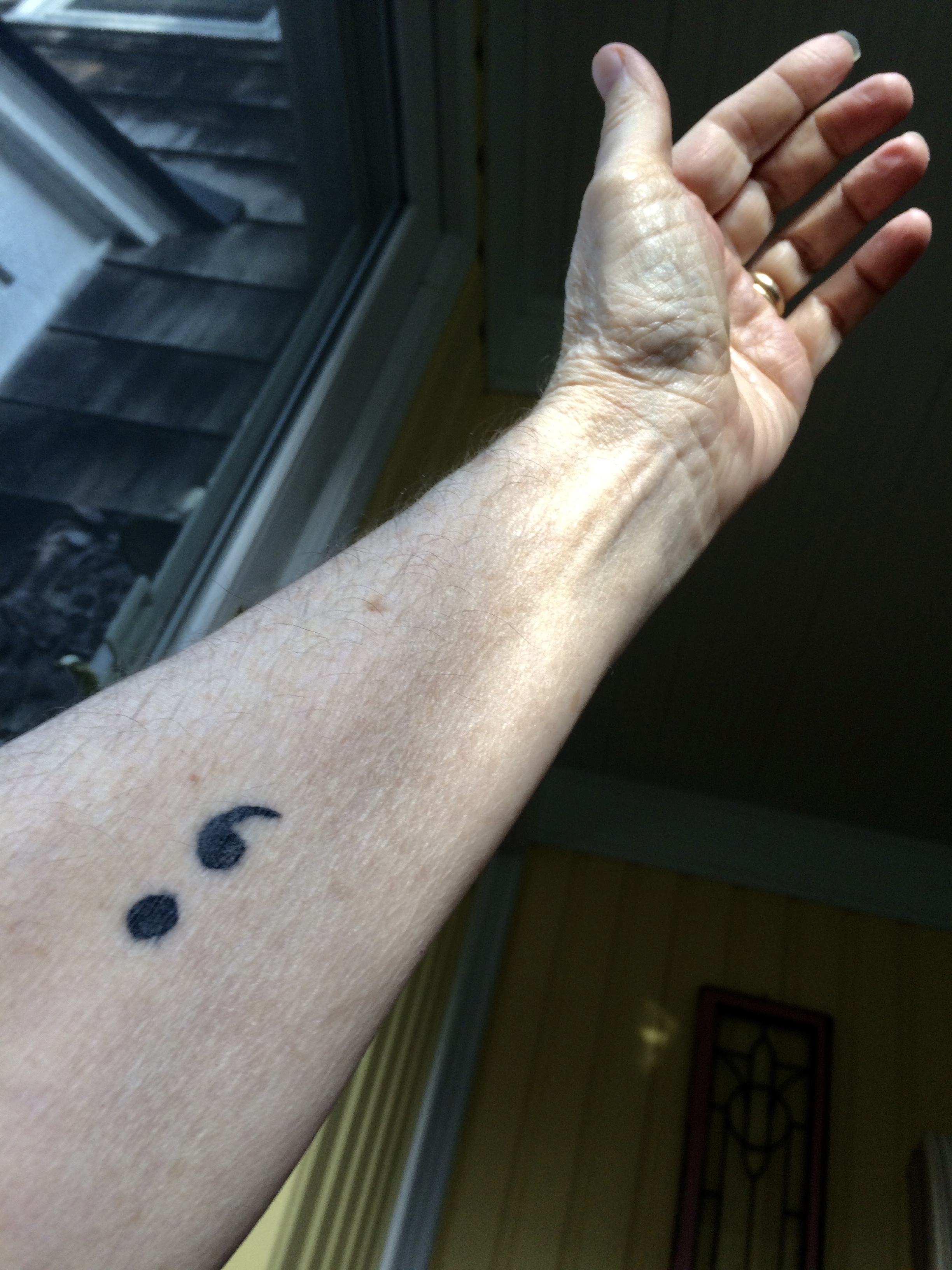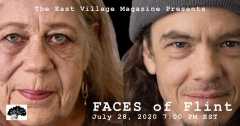By Jan Worth-Nelson
Some time in the middle of February – by far the longest, the damnedest, the cussedest month of the year in these parts–I got a severe attack of cabin fever. I’d been sick half the winter and between stink bugs, porn stars, scabs of snow everywhere, a terminally ill friend, threats of bottled water cutoffs, several bouts of existential dread in the middle of the night—well, let me just say that my tiny fastidious doses of Xanax were no longer enough.
I felt the need for a desperate measure.
I knew what I wanted. I wanted needles applied to my skin. I wanted to wear some ink.
Before I had a chance to change my mind, I plunked down into a black leather chair in a shop on Kearsley Street, my arm strapped down, and Zach set to work on my first tattoo.
Other than extreme schizoid flailing between ennui and exasperation with the world, what propelled me into that chair was my love of the semi-colon.
That is my tattoo, simple dot and lovely flourish of the comma, paired clearly where I can look at it anytime I want, for the rest of my life. I love my semi-colon tattoo.
 I am a person of ink and stories. One of my favorite scents is the smell of ink, intoxicating and soul-satisfying every time we go out to Riegle Printing to check on the magazine, for example. That scent floods into my body—I get an actual high, a rush of endorphins–and reminds me of work that I love and value almost above all else: the written word. I cry at the Huntington Library in Pasadena every time I stop in to gaze in awe at their Gutenburg Bible. My photo of the printing press—long gone–at the first newspaper I ever worked at, the Daily Gate City In Keokuk, Iowa, is, to me, possibly the most beautiful photo I’ve ever taken.
I am a person of ink and stories. One of my favorite scents is the smell of ink, intoxicating and soul-satisfying every time we go out to Riegle Printing to check on the magazine, for example. That scent floods into my body—I get an actual high, a rush of endorphins–and reminds me of work that I love and value almost above all else: the written word. I cry at the Huntington Library in Pasadena every time I stop in to gaze in awe at their Gutenburg Bible. My photo of the printing press—long gone–at the first newspaper I ever worked at, the Daily Gate City In Keokuk, Iowa, is, to me, possibly the most beautiful photo I’ve ever taken.
Ink is dying out as a means of communicating, of course—all the more reason why I am so happy to have it permanently on my body. I was born into a world of ink and will depart it in a world of atomized chips and pixels, far removed from the body’s experience of smell and taste and texture. I mourn that change from time to time.
But there will never be an end to stories. There is always more than one story. And no matter where you come in or opt out, there are always different ways to tell the story – a dizzying range of hypertexts: different villains, different heroes, different beginnings, different tantalizing details, different unintended consequences, different twists, different endings.
The semi-colon stands for all that. It means that there is more to the story.
It means that there is more to come.
If you live in Flint, you need that hope.
We are a city wrestling with its stories. We have our Sit-Down Strike story, we have our General Motors abandonment story, we have our “Roger and Me” story, we have our ghostly ruin porn story. We have our crazy city council story.
And of course we have our water crisis story, wrenching and borne with a heavy load of tragedy, anger, betrayal, struggle.
 And, much on my mind lately, we have our NetFlix “Flint Town” story, dark and in its darkness a certain devastating world-class lusciousness, the way violence can be beautiful, and yet we hate what we see there and alternately want to turn away and can’t take our eyes off of it, our moral consciousness roused and palpitating wildly like a heart taken out of a body and still alive on a metal tray.
And, much on my mind lately, we have our NetFlix “Flint Town” story, dark and in its darkness a certain devastating world-class lusciousness, the way violence can be beautiful, and yet we hate what we see there and alternately want to turn away and can’t take our eyes off of it, our moral consciousness roused and palpitating wildly like a heart taken out of a body and still alive on a metal tray.
And, also much on my mind lately, we have the Flint glass story, what’s happening at the Flint Institute of Arts. You have to see it. The 140 pieces of the new Glass Glass collection (that is not a typo—look it up) are stunning. The new hot shop, where glass maestro Brent Swanson presides over the earth, air, fire and water dramas will shake up your whole view of the Flint you live in. You can go and see it free every Saturday.
These two stories stand in startling contrast to each other. But they are both our stories.
I moderated a panel discussion at the Flint Public Library last month at which five passionate Flint leaders plus 100 others in the audience tried to grapple with the hard truths of the “Flint Town” story, released on NetFlix March 2. (For a full account of that event, co-sponsored by EVM and the Flint Area Public Affairs Forum, read Harold Ford’s April 12 report here) The pain and anguish prompted by the series, a searing look at the Flint police department, flew back and forth from the dais like exhaust fumes.

Isaiah Oliver at the “Flint Town” panel, Worth-Nelson at podium (Photo by Edwin D. Custer)
Isaiah Oliver, president and CEO of the Community Foundation of Greater Flint, moaned at one point, “We can’t compete with all of the negative things that existed in this series…It’s Roger and Me Two…We can’t share enough positive stuff to offset the negative.”
Brian Willingham, a retiring Flint police officer, pastor and writer, countered that to reject the reality of Flint Town was disingenuous and a case of denial. “We might miss the opportunity to talk about the problem,” he said. “Let’s first talk about structural racism, about the decline of our neighborhoods, the lack of jobs, the failure of the school system, the drugs, and guns.” Thank you, Brian!
But Oliver protested again that the truths of Flint Town overwhelm other big true stories, positive and hopeful. “Who decided that this view was going to be shown? And as a resident of this community, I don’t have control of the brand and I’m not sure who does.”
Much as I hate the word “brand,” — this is a city, not a bottle of shampoo, for gosh sake — I appreciate his angst. “Flint Town” is art by outsiders—brilliant and persuasive. It’s infuriating when our truths are mediated by others– and often elucidating, if we can control our self-defenses. Trying to “control the narrative” is misdirected energy. Embracing our truths with a stout heart and faithful effort is the brave choice we make day after day.
Oliver, in fact, leads the foundation that recently reported that $18 million has been received in donations for the Flint Child Health and Development Fund from the Flint water crisis. In my mailbox recently arrived a report, detailing how those donations—20,647 gifts from all 50 states and 15 countries—are benefiting Flint children. This is a Flint story.

Glass art makers at the FIA (photo by Jan Worth-Nelson)
And then, there’s the FIA. At the opening celebration for the new wing April 21, six representatives from Flint’s religious communities were given an opportunity to speak. I loved their diverse voices. One of them, Fr. James Mangan of St. Matthew’s Catholic Church, quoting Russian novelist Feodor Dostoevsky, said, “The world will be saved by beauty.” If that’s so, the FIA is a powerful oracle. “Life is about more than just surviving,” Fr. Mangan said.
This, too, is a Flint story.
At the press preview for the FIA opening, I pressed Neal Hegarty from the C.S. Mott Foundation on the significance of the $14 million FIA project proceeding parallel to the city’s water crisis; the FIA broke ground for the expansion—with $8.5 million backing from the Mott Foundation—in the dreadful water crisis summer of 2016.
How the city wrestles with its dualities is consequential: I could feel it in Hegarty’s response.
Acknowledging “the trauma the city has been put through,” he pointed out the Mott Foundation also had committed $100 million to the city’s water crisis response.
“We really feel that the community needs to move forward,” he said soberly. “There is still a future—a positive future.”
The propelling positives of “education, discovery and creativity,” as Hegarty ticked them off, the arts and culture, are stories being written here, “a vital component to a healthy community anywhere,” he said, “no matter what it’s been through.”
So, our story is a story of stories—and if you miss that plurality, you’re not getting Flint. Our stories are complex, exasperating, conflicting. Some are silly and dumb. We are both a cautionary tale and a preach-out of resilience, inventiveness and style. We’re about ruin and beauty and failure and abandonment and the downright stubbornness of boot-strap success. They’re all our stories.
That’s why I love my tattoo. Anytime I doubt any of this, I just look at my arm. In Flint, there’s always more to the story; there’s always more to come. It ain’t over yet.
EVM Editor Jan Worth-Nelson can be reached at janworth1118@gmail.com.
‘



You must be logged in to post a comment.